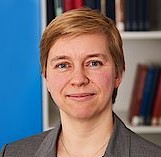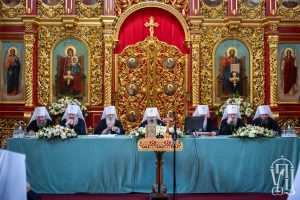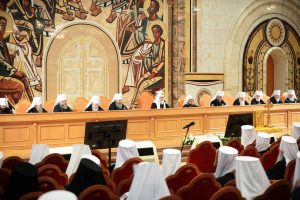
Regina Elsner is a researcher at the Centre for East European and International Studies (ZOiS) in Berlin.
A year ago, a few days after the full-scale invasion of Ukraine by the Russian army, I wrote a post here about the final split between Russian and Ukrainian Orthodoxy. This split was inevitable due to the “scandalous ignorance of the situation of the people in Ukraine, whom [Patriarch Kirill] claims to defend, a deliberate reversal of perpetrator and victim, and [the] open support of the ideology of the murderous regime” by the leadership of the Russian Orthodox Church (ROC).
Already in March 2022 it was obvious that the relationship between the two branches of the Moscow Patriarchate—the Ukrainian Orthodox Church (UOC) and the ROC—was irreparably broken. However, it was hard to anticipate how this break would translate into ecclesial praxis. Many hoped for an acceleration of the process of unification or at least a rapprochement of the Ukrainian Orthodox Church and the Orthodox Church of Ukraine (OCU), which failed in 2018. These hopes demonstrated a misinterpretation of the nature and depth of the mistrust between both churches, which appears to be stronger than the UOC’s disappointment with the Moscow Patriarchate. The UOC’s relationship with the leadership in Moscow simultaneously unfolded its full toxic effect and proved the Church’s May 2022 decision about “full independence from the Moscow Patriarchate” to be an ineffective declaration.

The Moscow Patriarchate appropriated the UOC for its own purpose as “new martyrs for their faith,” the “canonical church in Ukraine,” which under “massive political repressions” is forced to publish statements of independence but remains an organic part of the Moscow Patriarchate. For the expert commission assigned in December 2022 to provide an evaluation of all relevant UOC documents regarding links to the Moscow Patriarchate, these ROC claims are among the proofs of the churches’ remaining interdependence, which disenfranchises the UOC and deprives it of control over its identity. The way the ROC in concert with the Russian government presented the question of what they called “persecuted Christians” at the UN Security Council in January 2023, and the desperate effort of the UOC to debunk its instrumentalization while at the same time echoing the ROC’s argument for state pressure, aptly depicted the ambiguous relationship between both churches.
These short sketches illustrate the complexity of church relations in times of war and the fact that a purely political approach is insufficient to grasp this complexity. The last months reveal several layers of challenges for the UOC to find a way out of the obvious dead end it maneuvered itself into. There is, first, an undeniable common ecclesial, social, and cultural history shared by the Kyivan and Moscow Orthodoxy, which is unlikely to be disentangled by public or elite decisions. Longtime projects coordinated by the Ukrainian Greek–Catholic Church have attempted to elaborate a concept of “Kyivan tradition,” which is contested in Ukraine itself due to unclear boundaries and content. The Orthodox were hesitant to join the projects until 2019, and an orthodox evaluation of the commonalities and essential differences in relation to the Moscow tradition would indeed be even more challenging. Such an engagement is not possible during the war, especially if it prioritizes academic integrity and spiritual responsibility over popularity in order to be sustainable in different political circumstances.
Second, UOC canonical relations to the Moscow Patriarchate are not simply contracts with a cancellation period. As the 2023 opinion of the expert commission mentions, the UOC leadership—including almost all bishops—was part of the 2017 ROC Bishops Council in Moscow, which approved the amendments to the ROC charter preserving the UOC’s attachment to the ROC. This was not a forced decision imposed on the UOC episcopate, and it dates three years after the annexation of Crimea and the war in eastern Ukraine.

The question of church unity is not only a question of structures but also of unity in faith and, most importantly, of obedience to the next hierarchical level. Thus, we haven’t seen a serious attempt by the UOC leadership to reconsider its ambiguous relation to Moscow since 2014, which could counter the accusations of links with the ROC raised in the 2023 expert opinion and shared by broad parts of Ukrainian society.
This leads to a third layer of challenges, which relates to ecclesial self-understanding: a fundamental lack of self-criticism. This is not as banal as it might seem, and it is by no means exclusive to the UOC or the ROC, or even to Orthodoxy. The deep Christian idea of repentance is conceptualized only on the level of individual spirituality and conscience but not as a structural or social necessity. That means that the church is unable to admit failure as a social system or even sin as an institution. However, without such a process all efforts of the UOC to demonstrate its independence will lack credibility in the eyes of society and a large portion of believers. The same would apply to the ROC if it ever wanted to repair its relationship with Ukrainian Orthodoxy.
Fourth and finally, the dead-end relationship between the Moscow Patriarchate and the UOC is also a problem of stratification within the churches. In both churches, large portions of active parishioners (which constitute a small group among all statistical Orthodox in both countries) are disconnected from their local bishops and relate their confessional belonging to their parish and local priest. Their position on this war and on the question of church relations is difficult to ascertain, but social media monitoring and some surveys [1] point to a growing gap between them and the churches’ leaderships, and a greater identification with general civil society moods.
For Ukraine, this has two effects. On one hand, in the first months of 2022, the majority of parishes quit commemorating Patriarch Kirill without waiting for a decision from the UOC hierarchy and thus forced leaders to take action. However, the sincerity of the bishops’ decisions regarding the full split with Moscow remains questionable, as many bishops were not proactive and were more likely afraid of losing large portions of their flock or, perhaps, being prosecuted by the state. It may be that bishops are therefore, in principle, not against staying with the Moscow Patriarchate if only the war or the ROC’s support of the war would stop.
It must be admitted that not all solutions are in the hands of the UOC alone. In particular, the question of autocephaly and the task of securing canonicity for those faithful in Ukraine who don’t want to join the OCU urgently needs the involvement of other Orthodox churches to facilitate a whole-hearted split with Moscow. However, the development of a distinctive Kyiv Orthodox identity, a theology of collective responsibility and repentance, and new theological and structural efforts to empower laity could help strengthen the UOC’s growing independence from the Moscow Patriarchate. In the end, no structural—and “provable”—independence can replace the sincere theological turn from the destructive legacy of the ROC.
[1] A survey from December 2022 shows a significant loss of trust in the Church among Ukrainians. A survey from the Razumkov Center in February 2023 shows that the overwhelming majority of Ukrainians identify as civilians of Ukraine.
